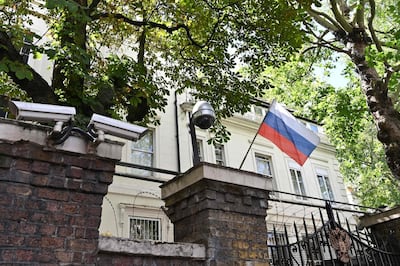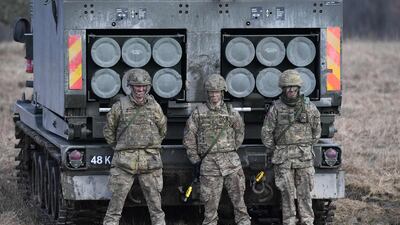There was a time when just about everyone knew the jargon of ICBMs and a nuclear missile’s throw weight. I could even recite the differences between START I, START II and the INF treaty, but I have had to look it all up again to check the details. The INF – Intermediate Nuclear Forces – treaty was a landmark in ending the Cold War.
Former US President Ronald Reagan and his Soviet counterpart Mikhail Gorbachev signed it in 1987. It eliminated all nuclear and conventional ground-launched ballistic and cruise missiles with ranges of 500 to 5,500 kilometers. Then came START I, a treaty signed in 1991.
It set a cap on nuclear warheads and fixed a total of 1,600 intercontinental ballistic missiles (ICBMs) and bombers. All that technical jargon, all those complex negotiations and treaties had one purpose: to stop human stupidity from wiping out all of us in a nuclear war.
But we need to think about it all again. In a wide-ranging review of the UK’s defence and foreign policy priorities, Prime Minister Boris Johnson wants to increase the cap on British nuclear weapons by 40 per cent from 180 to 260 nuclear warheads.
The US and Russia have also signalled a change in direction. On 2 August 2019 they abandoned the 1987 INF treaty’s conditions, the last of those Cold War agreements. The possibility of a 21st century nuclear arms race motivated Harvard professor Serhii Plokhy, a historian of previous nuclear crises, to write that “today, we are back to a situation that resembles the period preceding the Cuban missile crisis.”
That was in October 1962. The USSR has provocatively placed missiles in Cuba and President John F Kennedy faced them down. Cold War tension evolved into a strategy known as MAD – Mutually Assured Destruction. One false move and we all die.
But that’s why Britain’s re-ordering of its foreign and defence priorities signals the UK joining in what could yet become a new – and seriously unwise – MAD nuclear arms race. The UK’s defence review treats Russia as a “hostile state” and China primarily as a commercial “competitor” but one with the potential for conflict. The UK has four Vanguard class submarines, which can each fire up to 16 Trident missiles, and each missile can carry up to 12 warheads.
At least one submarine is at sea at any one time. But the submarine base is at Faslane in Scotland and the Scottish National Party, which is demanding another referendum on Scottish independence, wants the submarines and the missiles out of Scotland. That political problem is made worse by a practical one.

Production of British nuclear warheads is at the top security UK Atomic Weapons Establishment (AWE) at Aldermaston in Berkshire, and that has its own problems. According to Royal United Services Institute (RUSI) reports, even before the proposed increase in production, “the UK is embarking on the complicated and sensitive task of building a new nuclear warhead – something it has not done for 30 years, and has never done without nuclear-explosive testing, which it has now foresworn.” RUSI experts say this task alone will probably take around 17 years, even before factoring the new increase in overall production.
Moreover, Aldermaston has endured successive failures in completing hugely important projects on time and on budget including “for assembling and disassembling warheads” codenamed Mensa, “for handling enriched uranium components (Pegasus) and for conducting hydrodynamic-radiographic experiments (Hydrus)” There has even been a £1 million fine on the AWE for health and safety offences, and a shift from the involvement of private companies to more state control.
All these problems comes as the Biden administration has made clear it is breaking with Donald Trump’s relatively cosy attitude towards Moscow. China, in the view of Western defence experts, has become more assertive, and big power rivalry is extending even to the Arctic.
New, strategically important, Arctic sea routes are emerging as global warming opens up once frozen sea corridors around the polar ice cap. The worst case risk is that we are entering a second nuclear age of escalation and possible confrontation, one which could be more dangerous than even the Cold War. There are more players too.

North Korea has nuclear weapons. Iran has obvious ambitions to join the club. The decades of fear which brought about the Reagan, Bush, Gorbachev and Yeltsin arms control treaties have faded from memory. Yet there are grounds for hope.
Presidents Biden, Putin and Xi are all pragmatists. They may be suspicious of each other but after the economic disruption from Covid-19, no one secures a clear advantage from more dislocation in world affairs. As for Mr Johnson’s nuclear ambitions, he tends to promise ambitious schemes which often don't come to anything.
The Garden Bridge across the Thames, the London airport on the sea, the ludicrous idea of a tunnel or bridge between Scotland and Northern Ireland are fantasies typical of a man who likes making big announcements and fails to make them work.
More nuclear weapons? No thanks.
Gavin Esler is a broadcaster and UK columnist for The National



